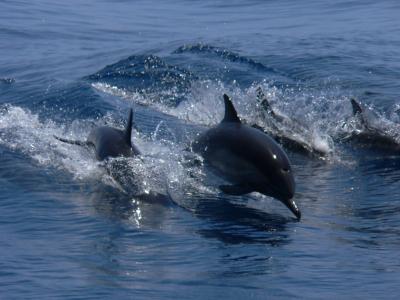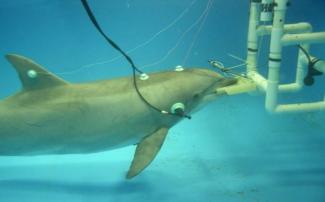Although it is now well-recognized that intense underwater noise from offshore activities can potentially harm cetaceans (whales and dolphins), scientific research to understand these impacts only began just over 40 years ago. Dr. Shane Guan, a BOEM oceanographer, recently published a review paper with the Marine Mammal Commission that summarizes the history of research efforts on anthropogenic noise effects to cetaceans.
The review focused on several research themes, including impacts from underwater detonation; field observation of behavioral responses to seismic surveys; hearing threshold and noise-induced auditory effects; controlled exposure experiments on noise exposure; auditory masking; and physiological stress from noise exposure. These topics are relevant to BOEM’s environmental assessment and decision making when planning offshore energy and resource activities, and important information to help researchers, industries and regulators understand potential impacts to cetaceans.
The review found that BOEM’s Environmental Studies Program (ESP) has led most of the pioneering studies on behavioral responses of cetaceans from exposure to noise from industrial activities (such as marine seismic surveys, offshore oil drilling and coastal constructions) from the early 1980s through the 1990s. These studies contributed to the fundamental knowledge of the range of adverse effects underwater noise could cause to cetaceans and were incorporated into a seminar book Marine Mammals and Noise, which is still widely referenced by researchers, industries, regulators, and resource managers for underwater noise impact assessments. Results from some of the ESP studies are the basis for marine mammal behavioral harassment criteria under the Marine Mammal Protection Act and are still used today. ESP continues to expand our knowledge of noise effects on cetaceans in the 21st century with several major studies, including controlled exposure experiments on sperm whale and humpback whale behavioral response to seismic sound exposure, and on the low-frequency hearing sensitivity of baleen whales.
In addition to synthesizing the past research efforts and progress on noise effects to cetaceans, the paper also identified remaining information gaps. Some these gaps include comprehensive investigations on cetacean behavioral response beyond simply sound levels and noise-induced auditory effects from realistic sound exposure scenarios. With the increase in offshore renewable energy development to help reduce the impacts of climate change, addressing these questions will help BOEM better assess the potential effects on these protected species and provide appropriate mitigation and monitoring measures to minimize any impacts.
Photo credit: the U.S. Navy
-- BOEM --
The Department of the Interior’s Bureau of Ocean Energy Management (BOEM) is responsible for America’s offshore energy and mineral resources. The bureau promotes energy independence, environmental protection and economic development through responsible, science-based management of energy and mineral resources on the U.S. Outer Continental Shelf.




